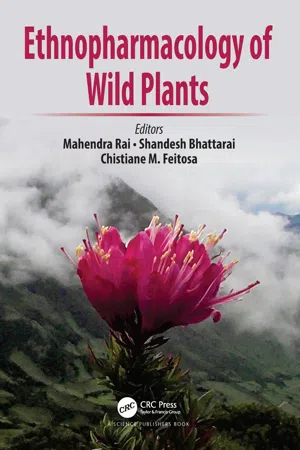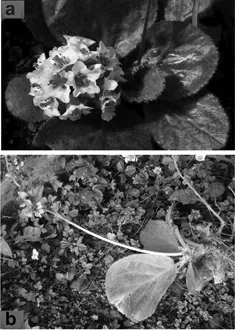
- 418 pages
- English
- ePUB (mobile friendly)
- Available on iOS & Android
Ethnopharmacology of Wild Plants
About This Book
The book provides valuable information on wild plants and their ethnopharmacological properties, discussion on ethnobotany, phytotherapy, diversity, chemical and pharmacological properties including antifungal, anti-inflammatory and antiprotozal properties. The chapters include a wide range of case studies, giving updated evidence on importance of wild plant resources from different countries including Nepal, India, Brazil, Chile, Argentina, Colombia, Egypt, Peru, etc. In addition, some specific species are used to explain their potential properties. Discussing traditional usage and pharmacological properties of wild plants, this book is entirely different from other related publications and useful for the researchers working in the areas of conservation biology, botany, ethnobiology, ethnopharmacology, policy making, etc.
Frequently asked questions
Information
Section II
Ethnobotany and Phytotherapy
Chapter 10
Distribution and Use (Ethnobotany and Trade) of Bergenia ciliata (Haw.) Sternb. in Nepal
Email: [email protected]
Introduction

Approach and Methods
Synonyms and Vernacular Names of Bergenia ciliata
| Language | Names |
|---|---|
| Amchi | Khadhur |
| Arabian | Junteyenah |
| Assamese | Patharkuchi |
| Baitadeli, Doteli | Vedaite, Silphode, Dhungeful |
| Bengali | Patharchuri |
| Chinese | Honhitao |
| Danuwar | Simtadi |
| English | Rock-foil, Hairy bergenia |
| German | Steinbrech |
| Gurung | Padambet, Pakhanved |
| Gujarati | Pashanbheda |
| Hindi | Pakhenbhed |
| Japanese | Yukinoshita |
| Kannada | Alepgaya, Pahanbhedi, Hittaga, Pasanaberu, Hittulaka |
| Kashmir | Pashanbhed |
| Marathi | Pashanbheda |
| Kham | Gatik mukpo |
| Kumaoni | Patharchud |
| Magar | Hangpaat |
| Malayalam | Kallurvanchi, Kallurvanni, Kallorvanchi |
| Nepalese | Dhungri kojara, Pakhanbedha, Pashanbhed, Silparo, Silpu, Simpate, Silphode |
| Oriya | Pasanbhedi, Pashanbheda |
| Pakistan | Zakham-e-hayat, Bhat-pay |
| Persian | Gashah |
| Punjabi | Kachalu, Pashanbhed |
| Rai | Ghayabatam |
| Sanskrit | Ashamabhed, Aswamahan, Nagamit, Pasanved, Pashana veda, Samwata, Silaved, Upalbhedi |
| Sherpa | Chyucha, Chyurpu |
| Sinhalese | Pahanbeya |
| Tamil | Sirupilai |
| Tamang | Bregyal |
| Tibetan | A-ama-bhe-da |
| Tharu | Chihuli |
| Telugu | Kondapindi |
| Unani | Mukha |
| Urdu | Zahkm-e-hayat |
Taxonomy
Distribution

| SN | Name | Illustrations | ||||
|---|---|---|---|---|---|---|
| 1 | Bergenia beesiana hort. ex C.Schneider | ipni | ||||
| 2 | Bergenia biflora Moench | ipni | Tropicos | |||
| 3 | Bergenia bifolia Moench | Tropicos | ||||
| 4 | Bergenia ciliata (Haw.) Sternb. | ipni | Tropicos | powo | Press et al. (2000) | FoN |
| 5 | Bergenia cordifolia (Haw.) Sternb. | ipni | Tropicos | |||
| 6 | Bergenia coreana Nakai | ipni | Tropicos | |||
| 7 | Bergenia crassifolia (L.) Fritsch | ipni | Tropicos | powo | ||
| 8 | Bergenia delavayi (Franch.) Engl. | ipni | Tropicos | |||
| 9 | Bergenia emeiensis C.Y.Wu ex J.T.Pan | ipni | Tropicos | powo | ||
| 10 | Bergenia fortunei Stein | ipni | powo | |||
| 11 | Bergenia gorbunovii B.Fedtsch. | ipni | ||||
| 12 | Bergenia gorbunowii B.Fedtsch. | ipni | Tropicos | |||
| 13 | Bergenia himalaica Boriss. | ipni | Tropicos | |||
| 14 | Bergenia hissarica Boriss. | ipni | Tropicos | powo | ||
| 15 | Bergenia ligulata (Wall.) Engl. | ipni | Tropicos | |||
| 16 | Bergenia media Engl. | ipni | Tropicos | |||
| 17 | Bergenia milesii Stein | ipni | Tropicos | |||
| 18 | Bergenia × newryensis Yeo | ipni | ||||
| 19 | Bergenia orbicularis Stein | ipni | powo | |||
| 20 | Bergenia ornata Stein | ipni | ||||
| 21 | Bergenia pacifica Kom. | ipni | Tropicos | |||
| 22 | Bergenia pacumbis (Buch.-Ham. ex D.Don) C.Y.Wu & J.T.Pan | ipni | Tropicos | powo | ||
| 23 | Bergeniapurpurascens (Hook.f. & Thom.) Engl. | ipni | Tropicos | powo | Press et al. (2000) | FoN |
| 24 | Bergenia schmidtii (Regel) Silva Tar. | ipni | ||||
| 25 | Bergenia scopulosa T.P.Wang | ipni | Tropicos | powo | ||
| 26 | Bergenia siphilitica Raf. | ipni | powo | |||
| 27 | Bergenia smithii Engl. | ipni | ||||
| 28 | Bergenia spathulata Nagels ex Guillaumin | ipni | ||||
| 29 | Bergenia stracheyi (Hook.f. & Thom.) Engl. | ipni | Tropicos | powo | Press et al. (2000) | |
| 30 | Bergenia thysanodes (Lindl.) C.Schneider | ipni | Tropicos | |||
| 31 | Bergenia tianquanensis J.T.Pan | ipni | Tropicos | powo | ||
| 32 | Bergenia ugamica V.N.Pavlov | ipni | Tropicos | powo | ||
| 33 | Bergenia yunnanensis hort. | ipni | ||||
| 34 | Bergenia × media (Haw.) Engl. | powo | ||||
| 35 | Bergenia × schmidtii (Regel) Silva Tar. | ipni | powo | |||
| 36 | Bergenia × smithii (Engl.) | powo | ||||
| 37 | Bergenia × spathulata Nagels ex Guillumin | powo | ||||
Ethnobotanical and medicinal uses
Table of contents
- Cover
- Title Page
- Copyright Page
- Foreword
- Preface
- Contents
- Section I: Ethnopharmacology
- Section II: Ethnobotany and Phytotherapy
- Index
- About the Editors